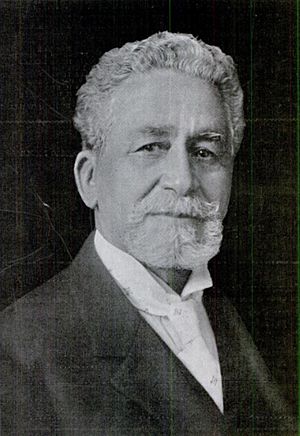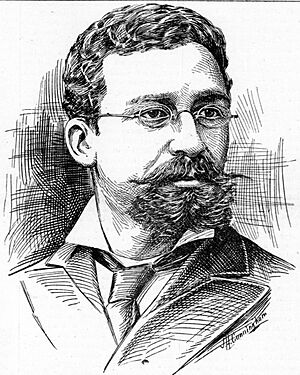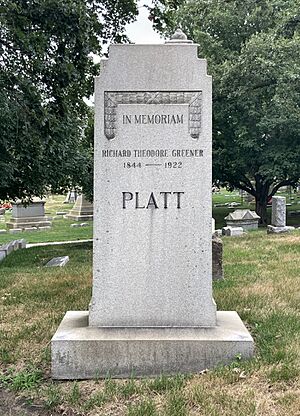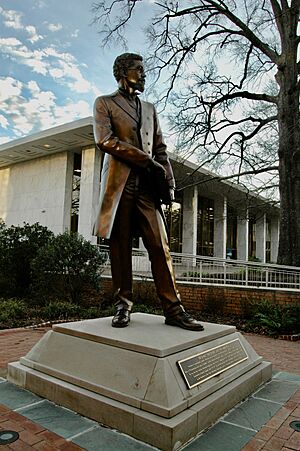Richard Theodore Greener facts for kids
Quick facts for kids
Richard Theodore Greener
|
|
|---|---|
 |
|
| Dean of Howard Law School | |
| In office 1878–1880 |
|
| Personal details | |
| Born | January 30, 1844 Philadelphia, Pennsylvania |
| Died | May 2, 1922 (aged 78) Chicago, Illinois |
| Resting place | Graceland Cemetery |
| Nationality | American |
| Political party | Republican |
| Children | Belle da Costa Greene and 8 others |
| Alma mater | Phillips Academy Andover Oberlin College (did not graduate) Harvard University (A.B.) University of South Carolina (LL.B.) |
| Profession | Professor, Diplomat, Attorney |
| Signature | |
Richard Theodore Greener (1844–1922) was a very important African-American scholar and leader. He was excellent at public speaking, philosophy, law, and classical studies during the Reconstruction era. He made history by being the first Black person to graduate from Harvard College in 1870.
Just three years later, he also earned a law degree from the University of South Carolina. He then became the first Black professor at that university. Before this, he worked as an editor for the New National Era newspaper, which was owned by Frederick Douglass.
In 1875, Greener was the first African American chosen for the American Philological Association. This is a main group for studying ancient languages and cultures in North America. He also became a lawyer in South Carolina and Washington, D.C. Later, he served as the leader (dean) of the Howard University School of Law.
In 1898, he became America's first Black diplomat to a country with a mostly white population. He worked in Vladivostok, Russia. He also represented America during the Russo-Japanese War, leaving this job in 1905.
The Chinese government honored him in 1902 for his help during the Boxer War and for helping people suffering from a famine in Shanxi. He received honorary law degrees from Monrovia College in Liberia in 1882 and from Howard University in 1907. Both Phillips Academy and the University of South Carolina give scholarships each year in Greener's name. Phillips Academy named a main area after him in 2018, and the University of South Carolina put up a statue of him that same year.
Contents
Early Life and Education
Richard Greener was born in Philadelphia, Pennsylvania, in 1844. His family moved to Boston in 1853. There, he could not go to public school because of his skin color. He went to a private school but left after a few years. He needed to work to help his family after his father left for the California Gold Rush and did not return.
One of his bosses, Franklin Benjamin Sanborn, helped him get into a special school (Oberlin Academy) at Oberlin College. After that, he went to Phillips Academy and finished in 1865. He studied at Oberlin College for three years. Then, he moved to Harvard College, where he earned his bachelor's degree in 1870. His acceptance to Harvard was seen as an "experiment" by the school. It opened the door for many more Black students to graduate from Harvard.
While at Harvard, he won the Bowdoin Prize for public speaking two times. A newspaper article from 1869 praised him. It said he was a hardworking young man who overcame challenges. He achieved a position he could be proud of through hard work, skill, and good character. The article also noted he was the first Black student to complete his studies at Harvard.
Academic Career
After graduating from Harvard, Greener worked as a principal at the Institute for Colored Youth in Philadelphia from 1870 to 1872. He then became principal of the Sumner High School in Washington, D.C., from January to July 1873. This was a school for Black students.
After leaving Sumner School, Greener briefly worked as an editor for The New National Era newspaper in 1873. He worked with the famous Frederick Douglass. He also helped edit the National Encyclopedia for American Biography.
University of South Carolina
In October 1873, Greener became a professor at the University of South Carolina. He taught philosophy and was the first African-American teacher at the university.
He also worked as a librarian there. He helped organize and list the library's books, which were messy after the Civil War. He also wrote a special report about the library's rare books. His job also included helping with Latin and Greek classes. He taught courses on International Law and the U.S. Constitution.
In 1875, Greener was the first African American to be chosen as a member of the American Philological Association. This is a main group for people who study classical languages and cultures in North America.
Howard Law School
Greener earned his law degree from the University of South Carolina. He was allowed to practice law in South Carolina in December 1876.
In June 1877, after the Reconstruction period ended in South Carolina, the university closed. Greener moved to Washington, D.C., and was allowed to practice law there in April 1877. He became a professor at Howard University Law School. He served as the dean (leader) of the law school from 1878 to 1880.
Public Service and Activism
From 1876 to 1879, Greener represented South Carolina in the Union League of America. He was also the president of the South Carolina Republican Association in 1887. He was active in freemasonry, a social organization. In 1875, the South Carolina Assembly asked Greener to join a group to improve the state's school system.
From 1880 to 1882, Greener worked as a law clerk for the U.S. Treasury.
In 1883, Greener and Frederick Douglass had a big debate. Greener and younger Black leaders believed it was time to move away from relying on political parties and white allies. Douglass disagreed, but Greener still respected Douglass's past achievements. Greener helped plan a large meeting to share the concerns of Black Americans with the nation. Many years had passed since the Civil War and the Emancipation Proclamation. Also, the Fourteenth and Fifteenth Amendments had been passed, giving Black people more rights. However, these rights were often ignored or taken away, and Jim Crow laws were spreading in the South. Greener and other young Black leaders questioned Douglass, who stayed loyal to the Republican Party. This party had fought for Black freedom but then seemed to abandon them.
From 1885 to 1892, Greener was the secretary of the Grant Monument Association. He helped lead the first efforts to raise money to build Grant's Tomb. People from all over the world donated money. From 1885 to 1890, he was the main examiner for the civil service board in New York City. In the 1896 election, he led the Colored Bureau of the Republican Party in Chicago.
Greener was also connected to Booker T. Washington, who believed in working with the system to achieve progress for African Americans. This was different from other leaders like William Monroe Trotter and W. E. B. Du Bois, who demanded full rights immediately. The ideas of Trotter and Du Bois led to the NAACP.
Diplomat
In 1898, President William McKinley appointed Greener as General Consul in Bombay, India. Soon after, he took a job as a United States Commercial Agent in Vladivostok, Russia. He successfully represented America during the Russo-Japanese War. He left the diplomatic service in 1905.
Personal Life
On September 24, 1874, Greener married Genevieve Ida Fleet. They had six children together.
Greener's daughter, Belle da Costa Greene, became the personal librarian for J. P. Morgan, a very rich businessman.
Later Life and Death
Greener settled in Chicago with his relatives. He worked as an agent for an insurance company and practiced law. He also sometimes gave talks about his life. He passed away from natural causes in Chicago on May 2, 1922, at the age of 78. He was buried at Graceland Cemetery.
His Harvard diploma and other personal papers were found in an attic in Chicago in the early 2000s. People are still discussing where these important papers should be kept.
Legacy
Richard Greener achieved many "firsts" for African Americans. He also received several awards during his life.
In 1902, the Chinese government gave him the Order of the Double Dragon. This was for his help during the Boxer War and for assisting people suffering from a famine in Shanxi.
He received two honorary Doctorates of Laws. One was from Monrovia College in Liberia in 1882, and the other from Howard University in 1907. Both Phillips Academy and the University of South Carolina offer scholarships each year in Greener's name.
The main quadrangle (a central area) at Phillips Academy was named after Greener in 2018. The University of South Carolina also put up a nine-foot statue of Greener on February 21, 2018. It stands in front of the Thomas Cooper Library.
In 2009, some of his personal papers were found in the attic of an abandoned home in Chicago by a demolition worker.




